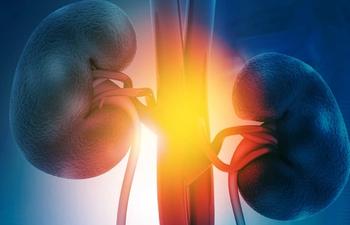
Role for Stereotactic Ablative Radiotherapy in Metastatic RCC?
Radiotherapy in advanced kidney cancer is generally only used in select metastatic settings, but the use of stereotactic ablative radiotherapy offers promise in a number of indications in this malignancy.
Radiotherapy in advanced kidney cancer is generally only used in select metastatic settings, but the use of stereotactic ablative radiotherapy (SABR) offers promise in a number of indications in this malignancy. An expert in the field discussed the present state of data and what future trials may show at the 15th International Kidney Cancer Symposium, held November 4–5 in Miami, Florida.
A primary obstacle in this field is the misconception that renal cell carcinoma (RCC) is radio-resistant, said Raquibul Hannan, MD, PhD, a radiation oncology at UT Southwestern in Dallas. Some research suggested that RCC cell lines were among the most resistant to radiotherapy among many malignancies, but Hannan said the work was somewhat flawed.
One study showed that RCC was the least radiosensitive among 76 different cancer cell types-but only when the dose was less than 3 Gy/fraction. “At a higher dose RCC is just as radiosensitive as any other cancer cell line,” Hannan said. In clinical experience, he added, RCC actually appears more radiosensitive than some other malignancies, such as lung and breast cancer.
The specific field where data on radiation therapy in advanced RCC has matured somewhat involves brain metastases, Hannan said. Studies have found excellent results in this area, with 90% to 100% tumor control rates for intracranial radiosurgery in RCC metastases. Deaths from brain metastases occur in a minority of patients in that setting.
The rationale for treatment of RCC metastases outside of the brain stems from surgical data, Hannan said. Though published data are lacking, he discussed some unpublished data from his center’s experience involving SABR for 175 lesions in 84 patients; 75 were treated with curative intent, and 100 were treated with palliative intent.
After a median follow-up of 16.7 months, the local control rate was 91.2%. The treatment was also very well tolerated, with acute grade 3 toxicities occurring in 1.7%, and late grade 3 toxicities occurring in 2.9%. Poorer local control was seen in patients where the treatment was palliative in intent, with spine metastases, and with more than one previous systemic treatment. On a multivariate analysis of this cohort, only the prior systemic therapy and a dose to 99% of the target volume were significantly associated with local control.
“What this means is that patients with multiple lines of systemic therapy would need a higher dose and coverage to control the tumor,” Hannan said.
SABR could also be used to delay the start of systemic therapy, with obvious benefit to patients’ quality of life. Again, Hannan discussed some unpublished data on 46 patients with RCC and oligometastases at his center, and said the experience has been positive so far. In this cohort, 49.2% were free from systemic therapy after 1 year.
Among patients who were treated with SABR with curative intent, the freedom from systemic therapy rate was 68.5% at 1 year, compared with 26.4% among those treated with palliative intent (P < .0001). Patients with IMDC favorable risk had a 64.3% rate of freedom from systemic therapy, compared with 48.5% for those with IMDC intermediate risk and 0% for unfavorable-risk patients. Finally, patients with one to three lesions had a 58.4% freedom from systemic therapy rate, compared with 11.1% for those with three-plus lesions (P < .0001).
There are some ongoing trials testing the use of SABR in metastatic RCC as well. For example, the i-SAbR IL-2 trial involved SABR followed immediately by IL-2 therapy in metastatic clear cell RCC. In the first 19 patients, there were 10 responders (partial or complete responses; 53%).
“The currently accepted role of SABR is really in the [central nervous system] setting,” Hannan said, but stressed that the accumulating data suggest a use for the therapy in other patients.
Newsletter
Stay up to date on recent advances in the multidisciplinary approach to cancer.
















































































